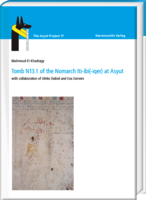|
|
more titles of the subject:
One of the important outcomes of the long-term Egyptian-German co-operation in archaeological fieldwork at the necropolis of Asyut is the discovery of Tomb N13.1 in 2005. The tomb was discovered by the members of The Asyut Project while surveying the necropolis of Asyut for the purpose of mapping. Tomb N13.1 belongs to the late First Intermediate Period/early Eleventh Dynasty Siutian Nomarch Iti-ibi(-iqer).
This discovery is the only available source of information introducing the then unknown Siutian nomarch Iti-ibi(-iqer). It provides us with a possible evidence connecting the well-known Siutian family of nomarchs, who ruled Asyut during the later part of the First Intermediate Period, i.e., Khety I, Iti-ibi and Khety II, and the celebrated nomarch Mesehti, owner of the two sets of model-soldiers representing Egyptian spearmen provided with shields (Cairo CG 258) and Nubian archers (Cairo CG 257), in addition to the two coffins (Cairo CG 28118, 28119). The tomb’s decoration is one of the best preserved late First Intermediate Period/early Eleventh Dynasty tombs known to us up to date. Its iconographic details present one of the earliest known examples of a fabulous creature in a hunting scene in a private tomb and the earliest known example of goddess Sekhet dominating a fowling scene in a non-royal context. Mahmoud El-Khadragy, now Professor Emeritus of Egyptology, Faculty of Archaeology, Sohag University, participated as field director of The Asyut Project for eleven seasons of fieldwork between 2003 and 2014. |






